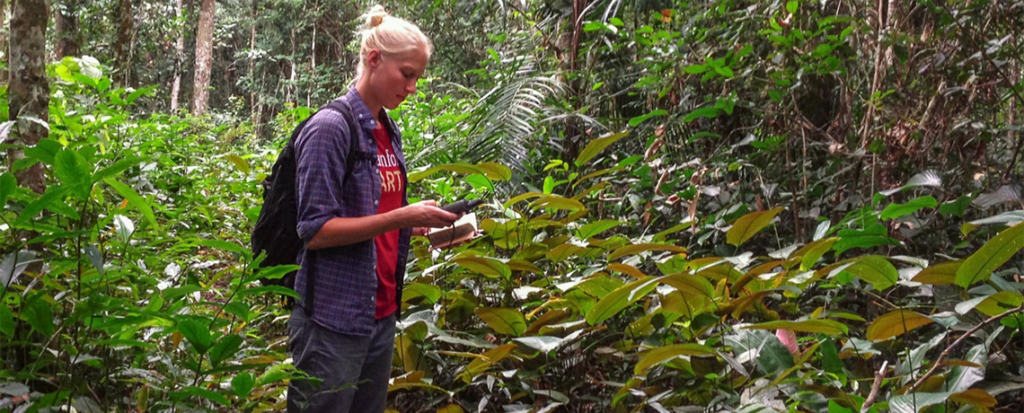
Lead researcher Elsa Ordway collects data to validate a remote sensing analysis of deforestation and agricultural expansion in Cameroon. (Image credit: Courtesy Elsa Ordway)
Multinational companies are increasingly looking to Africa to expand production of in-demand commodity crops such as soy and oil palm. A first-of-its-kind study highlights the real and potential impacts on the continent’s valuable tropical forests.
Next time you bite into a chocolate bar, think of Africa. The continent produces nearly 70 percent of the world’s cocoa, a growing output that requires carving more than 325,000 acres of new farmland from forests every year – a drop in the bucket of overall agricultural expansion there.
Lead researcher Elsa Ordway collects data to validate a remote sensing analysis of deforestation and agricultural expansion in Cameroon. (Image credit: Courtesy Elsa Ordway)
That expansion is the subject of a new Stanford study that provides the first comprehensive assessment of how international demand for commodity crops, such as cocoa, is affecting sub-Saharan Africa’s tropical forests, second in size only to the Amazon. The findings, published in Environmental Research Letters, suggest reason for hope if policymakers tailor decisions regarding deforestation around the region’s unique dynamics and uncertainties.
“We are starting to better understand issues related to large-scale agricultural expansion in the tropics,” said lead author Elsa Ordway, a graduate student in Stanford’s School of Earth, Energy & Environmental Sciences. “In Africa, we have the opportunity to take lessons learned from other regions and recommend preventive policies.”
In particular, the study recommends policies that would alleviate poverty in local regions and incentivize forest conservation rather than the widespread deforestation that has accompanied agricultural expansion in other regions.
Into Africa
As international markets have swelled and integrated, production of in-demand crops such as soy and oil palm has moved away from areas where land is scarce and where natural resource regulations are robust. Production has instead moved to tropical regions such as Southeast Asia and South America. Brazil and Indonesia alone accounted for more than 60 percent of global tropical deforestation from 2000 to 2005, largely due to agricultural expansion.
A Stanford study indicates that domestic demand for commodity crops has been associated with most agricultural expansion in sub-Saharan Africa in recent years, including oil palms such as these at an oil palm nursery and research facility in Cameroon. (Image credit: Elsa Ordway)
Sub-Saharan Africa, with its abundant cheap land and labor, would seem an obvious next step for multinational companies looking to expand farther. Since 2015, agricultural production in the region has grown at the fastest rate globally, and cropland is predicted to expand more than 10 percent by 2025.
Although deforestation rates in Africa remain well below those in South America and Southeast Asia, the region has lost an area of intact forest about the size of Iceland since 2000.
These African forests, contained primarily in the Congo Basin, represent almost 30 percent of the world’s total and are an important source of local income. In addition to regulating climate, safeguarding water quality and controlling disease, the forests feed and provide subsistence means to at least 100 million people living nearby. Forest products such as logs generate an average of 6 percent of sub-Saharan Africa’s gross domestic product – triple the world average.
